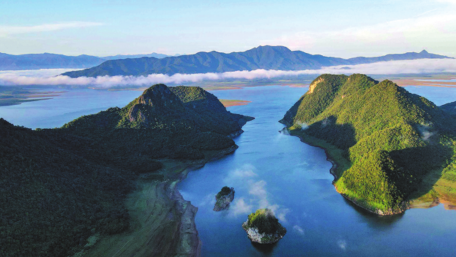China's southernmost Hainan province has maintained its focus on sound ecological development as it establishes a national ecological civilization demonstration zone and a free trade port that is set to become globally influential by the middle of the century, according to officials from the provincial government.
Dotted by 1,944 kilometers of coastline, 68 natural bays, the tropical island province has been endowed by nature with a unique diversified ecosystem and rich natural resources, including lush mountains, rainforests and wetlands, vibrant seaweed beds, colorful coral reefs and other mysterious marine creatures. It boasts more than 4,000 vascular plants, more than 2,500 kinds of medicinal plants and over 20 species of rare plants protected at national level.
Local authorities said that Hainan has put ecological conservation and green lifestyles high on its agenda in recent years and boosted a series of ecological landmark projects.
The highlights include the construction of the Hainan Tropical Rainforest National Park — China's largest contiguous tropical rainforest; promotion of prefabricated buildings; domestic waste classification and an islandwide ban of plastics and promotion of new energy vehicles. The unwavering efforts from the government and the public on biodiversity conservation and environmental protection have been rewarded, with admirable improvements and amazing new discoveries reported in the research of rare wild plants and endangered animal and plant germplasm resources.
Earlier this year, in the international journals of Mycokeys, Diversity and Phytotaxa, Chinese bioscientists unveiled their discoveries of eight new massive fungi species in the Hainan Tropical Rainforest National Park, one of China's five formally designated national parks, announced at the Leaders' Summit of the 15th meeting of the Conference of the Parties to the Convention on Biological Diversity, or COP 15, held in Kunming, capital of Yunnan province in 2021.
"The new fungi species play an important role in the recycling ecosystem of the rainforests and three of them have been used in antioxidant, bacteriostatic and anti-tumor pharmacological activities. Further study of them may lead to innovative drugs with wide prospects," said Ma Haixia, who made the discovery with her team from the Research Institute on Tropical Biotechnology under the Chinese Academy of Tropical Agricultural Sciences.
In the past three years, local scientists have observed at least 28 new species in the tropical rainforests. They included six new species of animals, nine new species of plants and 13 new species of fungi, according to a research report released earlier this month by the national rainforest park administration.
Located in the mountainous area of central Hainan island, the national park covers about 4,269 sq km, or one-seventh of the province's land area, and is known as one of the world's key germplasm resource banks that is home to 3,653 species of wild vascular plants and 540 species of vertebrates.
In the park, the only habitat of the critically endangered Hainan gibbon, or nomascus hainanus, to give its scientific name, has maintained growth in population. It is the only one of the 20 gibbon species that enjoys such a growing trend in the world, according to experts from the International Union for Conservation of Nature.
Jane Smart, global director of the IUCN's biodiversity conservation group, said that the steady recovery of the gibbon population in Hainan is evidence of China's achievements in ecological and environmental protection in recent years. Hainan's conservation efforts have renewed confidence in the protection of endangered primates around the world.
Chinese scientists placed an annual gross ecosystem price tag of about 205 billion yuan ($31.7 billion) on products and services at the Hainan Tropical Rainforest National Park last year, the country's first-ever GEP accounting for a national park. It aims to help people better understand the tremendous wealth offered by a sound environment and to promote coordinated efforts to boost environmental protection and socioeconomic growth. GEP summarizes the value of nature's contributions to sustainable socioeconomic development and effectively makes up for the inability of GDP accounting to measure natural resource consumption, ecological resources and environmental damage, said experts.
"The GEP accounting of the park provides a quantifiable yardstick for the country's development of an ecological civilization, showing that Hainan is promoting the new and green development concept through concrete efforts," said Li Yide, a researcher from the Chinese Academy of Forestry Sciences.
"Halophila ovalis, a new sea grass variety, has been found in the Dongzhai mangrove national reserve which is home to 69.4 percent of China's mangrove species.
"The area of mangrove seaweeds is increasing year by year thanks to restoration efforts in recent years," said Feng Erhui, an engineer with the reserve administration.
Experts on environmental study noted that the high frequency of new ecological and biological discoveries reveals the rich biodiversity of the tropical rainforest in Hainan, as well as the progress in ecological protection across the island province.
Government figures show that the province's annual concentration of PM2.5 — hazardous fine particles with a diameter of less than 2.5 microns — has been kept as low as 13 micrograms per cubic meter for the past two years, and forest coverage has stabilized at more than 62.1 percent.
"Compared with our old village, the new living environment is much better — it is spacious and comfortable. Children can go to the school nearby and the elderly can enjoy convenient medical services," said Wang Jiancheng, head of a village that has been newly relocated from a core reserve in the rainforest park. Resettled villagers will receive assistance such as public welfare jobs, lands for operating shops and subsidies for running factories, according to Hainan's regulations on compensation for ecological protection, which came into force in early 2021. Hainan will firmly implement the philosophy that "lucid waters and lush mountains are invaluable assets", accelerate the exploration of value realization mechanisms for ecological products, such as forest carbon sinks, marine carbon sinks, and ecological compensation, to play a leading role in the country's green development path, the provincial authorities said.

Hainan's natural beauty is clear to see.